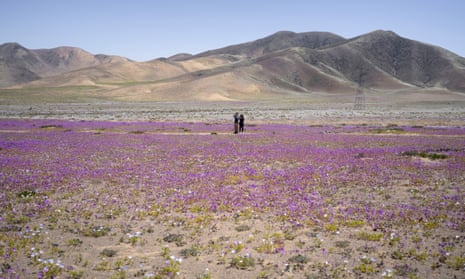Unusual winter rainfall has produced a floral bloom and explosion of colour on the barren plains of the Atacama desert, prompting Chile’s government to move to protect the area.
This month, the new president, Gabriel Boric, announced that the area would be made into a national park – the highest protected status the country bestows – to safeguard the flowering desert, a rare phenomenon which occurs every few years.
Although the exact area for the Flowering Desert national park is yet to be determined, it will sit between the northern cities of Copiapó and Vallenar in the Atacama desert – the driest place on Earth.
“This announcement is great news … and it is in line with our commitment to be an ecological government which puts people and nature first,” said Maisa Rojas, Chile’s environment minister.
Rojas, a renowned climate scientist who sat on the Intergovernmental Panel on Climate Change, said that people must “respect the desert even in its dormancy … because the seeds and bulbs are still there waiting for the new cycle”.

Every few years, more than 200 species of plants bloom, producing a spectacular carpet of purple, pink and yellow flowers on the desert floor. Many of the species are endemic to the area, including nolanas, huillis, and añañucas.
The plants are geophytes, meaning that their bulbs lie dormant underground over the dry period and, when the winter rains finally arrive, surface the following spring. Lizards, mammals and insects flock to the area when the flowers emerge, with desert foxes, rodents and guanacos joined by grasshoppers and butterflies.
The phenomenon usually follows El Niño, the warm phase of a weather system in the tropical waters of the Pacific ocean which prompts rainfall in coastal areas of the Atacama desert.
However, this year is La Niña, the cycle’s cold spell, making this bloom highly unusual. The last major bloom occurred in 2017, and scientists believe that the phenomenon could last into late November this year.
“All extreme biological systems are right on the edge of survival – that’s why it’s so important to protect them,” said Dr Cristian Atala, a professor at Valparaíso Catholic University’s institute of biology, who welcomed the government’s decision to declare the national park.
“The slightest push and these cycles are lost for ever because they’re more sensitive than most,” he added.

Although Atala says that tourists are largely respectful of the floral bloom, in the past people would often pick the flowers, damaging the chances of future events occurring.
“The flowers produce fruit and seeds, so if you take today’s flowers away, you are also taking the next floral bloom with you,” he explained.
The Boric government has made protecting biodiversity and animal wellbeing central to its programme for government, and promised to lead the fight on climate change.
The country is slowly shutting down its 21 remaining coal-fired power plants, and last week solar and wind overtook coal as an energy source in the national grid for the first time in the country’s history.
But Chile’s arid north, the mining powerhouse of one of South America’s strongest economies, is under particular threat.
“Although you don’t always see it, there is huge biodiversity in the desert, and there are many unique and endemic species,” said Cristina Dorador, a microbiologist from the port city of Antofagasta in northern Chile.
“But the desert is under threat from climate change, and mining in particular. It is imperative that we protect all of it, not just the flowers.”
